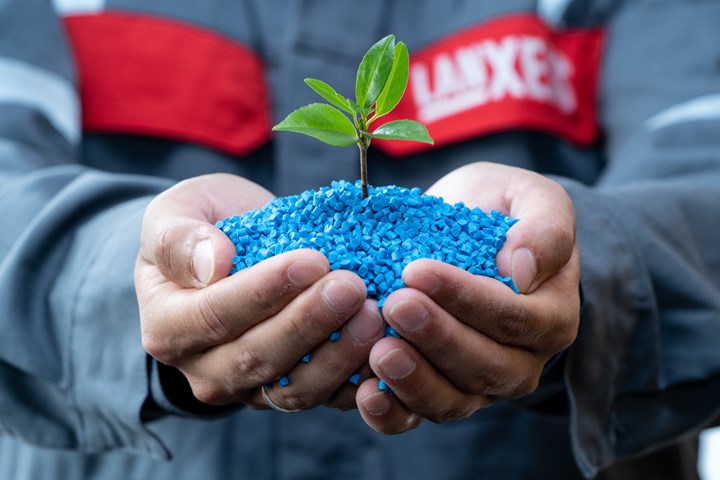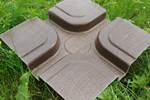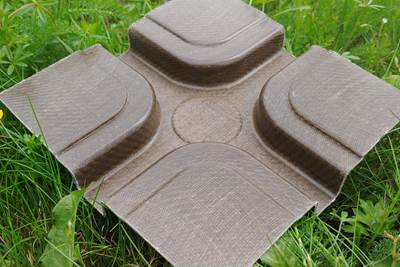Lanxess reveals highly sustainable Scopeblue composite material series
PA6 glass fiber-reinforced compound under Lanxess’ new Scopeblue series is made from 92% sustainable raw materials, with content goals headed toward 100%.

Lanxess is offering a new, particularly sustainable product under the name Durethan BLUEBKV60H2.0EF. Photo Credit: Lanxess
Lanxess (Cologne, Germany) introduces its latest product, Durethan BLUEBKV60H2.0EF, a glass fiber-reinforced compound that uses 92% sustainable raw materials, more than other prime quality glass-fiber-reinforced plastic the company notes. The new easy-flowing plastic grade is the first product in Lanxess’ new Scopeblue series, which identifies products that either consist of at least 50% circular (recycled or bio-based) raw materials, or whose carbon footprint is at least 50% lower than that of conventional products.
“A carbon-neutral future can become reality only if we start using more sustainable products,” says Frederique van Baarle, who heads the High-Performance Materials (HPM) division at Lanxess. “Our first product marketed under the Scopeblue brand represents a real solution for the circular economy. The compound is a certified premium material that’s based on sustainable raw materials.”
For example, cyclohexane is one raw material used in the production of the polyamide-6-based (PA6) product, and comes from a sustainable source, meaning it is either bio-based, recycled bio-based or produced by means of chemical recycling. Durethan BLUEBKV60H2.0EF is also strengthened with 60% by weight of glass fibers comprising industrial glass waste instead of mineral raw materials. Moreover, the alternative raw materials that Lanxess uses in the precursors for PA6 are chemically identical to their equivalents of fossil origin (“drop-in solutions”), so Durethan BLUEBKV60H2.0EF is reported to exhibit the same characteristics as the virgin material and can be processed just as easily using the same production tools and facilities with no conversion work needed.
“This high-strength, high-rigidity structural material can be deployed wherever its purely fossil-based equivalent, Durethan BKV60H2.0EF, has traditionally been used in series production — so in automotive construction for the production of car front ends, brake pedals and oil pans,” says Dr. Guenter Margraf, head of global product management at HPM.
Nevertheless, developers are setting their sights on more than 92% sustainable raw materials. “We’re currently working on increasing the content of sustainable raw materials in this compound to 100%,” says Margraf. This requires ammonia synthesized with carbon-neutral hydrogen. Over the medium term, the specialty chemicals company is also planning to replace the additives used in its plastics with sustainable equivalents.
With Durethan ECOBKV30H2.0, ECOBKV35H2.0 and ECOBKV60XF, Lanxess also recently unveiled three PA6 compounds containing 30%, 35% and 60% by weight respectively of recycled fiber made from glass waste as calculated using the ISCC Plus-certified mass balance method (defined below). In response to major customer demand, this product family has been extended over the past few months to include even more compounds based on PA6 and PA66. Lanxess is also using the recycled glass fibers for the mechanical reinforcement of its Pocan-brand polybutylene terephthalate (PBT) compounds. Early products include Pocan ECOB3235 and the flame-retardant ECOB4239, each of which contain 30% by weight of recycled glass fibers as calculated using the certified mass balance method.
Lanxess notes that the sustainable origin of all of its raw materials is certified to ISCC Plus (International Sustainability and Carbon Certification). This applies to Lanxess production sites in Antwerp, Belgium and Krefeld-Uerdingen, Germany, as well as all precursors originating exclusively from suppliers that are also ISCC Plus-certified.
Related Content
Owens Corning to sell glass fiber business to Praana Group
Transaction with India-based holding group completes Owens Corning’s previously announced strategic review of the business, strengthens its focus on residential and commercial building products.
Read MoreORNL demonstrates lightning strike protection tech for composites
Researchers, led by Vipin Kumar, developed a low-cost, recyclable carbon fiber wind turbine blade tip that showed resilience to high-voltage lightning strikes, with more innovations in store.
Read MoreZEBRA project demonstrates closed-loop wind recycling system
Consortium partners have proven the complete recycling of thermoplastic wind turbines via two manufactured wind blades, featuring reduced operating cost, CO2 emissions.
Read MoreThermoplastic composite pipes provide 59% reduction in H2 distribution CO2 emissions
Hive Composites’ multilayer thermoplastic composite pipe (TPC) design meets hydrogen permeation requirements while ensuring substantial CO2 reductions compared to conventional steel pipe systems.
Read MoreRead Next
Lanxess launches renewable, biocomposite material
The material combines natural flax fibers with bio-based polylactic acid, which acts as the matrix, for a material that is 100% recyclable.
Read MoreUltrasonic welding for in-space manufacturing of CFRTP
Agile Ultrasonics and NASA trial robotic-compatible carbon fiber-reinforced thermoplastic ultrasonic welding technology for space structures.
Read MoreCeramic matrix composites: Faster, cheaper, higher temperature
New players proliferate, increasing CMC materials and manufacturing capacity, novel processes and automation to meet demand for higher part volumes and performance.
Read More












